This is an Aires Radar-Eye, a 35mm rangefinder camera made by Aires Camera Ind. Co., LTD in 1960. The Radar-Eye would be the the most advanced rangefinder camera produced by Aires, and also it’s last. Built on the same platform as the previous Aires 35 IIIC, the Radar-Eye added a coupled selenium exposure meter with both a top plate and through the viewfinder match needle readout, and an all new Seikosha-SLS shutter with a top speed of 1/1000 which was rare for a leaf shutter camera of the day. The Radar-Eye was an attractive and well built camera, that like previous Aires cameras, came with an excellent 6-element Coral lens that was capable of excellent shots, but sadly was short lived as the company would go out of business less than a year after it’s release.
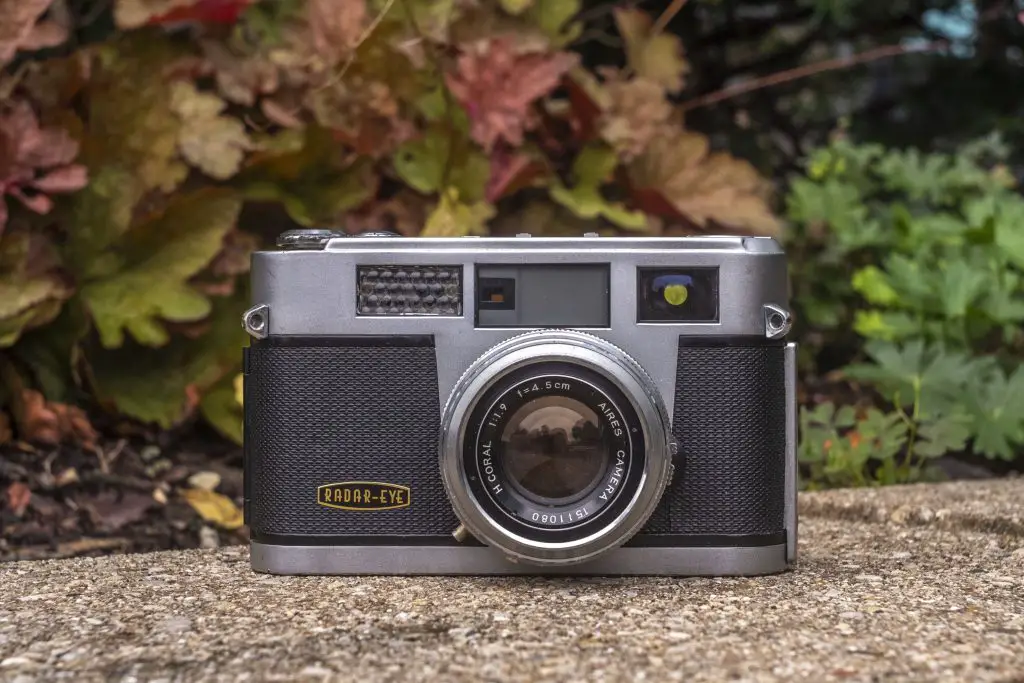 Film Type: 135 (35mm)
Film Type: 135 (35mm)
Lens: 4.5cm f/1.9 Aires H Coral coated 6-elements
Focus: 3 feet to Infinity
Viewfinder: Coincident Image Coupled Rangefinder w/ exposure meter readout
Shutter: Seikosha-SLS Leaf
Speeds: B, 1 – 1/1000 seconds
Exposure Meter: Coupled Selenium Cell
Battery: None
Flash Mount: Coldshoe and M and X Flash Sync
Weight: 801 grams
Manual: https://www.cameramanuals.org/pdf_files/aires_radar-eye.pdf
How these ratings work |
The Aires Radar-Eye was the last and most advanced 35mm rangefinder camera produced by Aires before they went bankrupt. Featuring a Seikosha leaf shutter with a top speed of 1/1000, a coupled selenium exposure meter that is visible from the top plate and within the viewfinder, automatic parallax correction, an excellent 6-element f/1.9 Coral lens, and a clean body with some clever design, the Radar-Eye has pretty much everything you could expect from a mid century 20th century camera. The camera is well built, easy to use, and produces outstanding images. Very few were made, so they can be hard to find today, but like most Aires cameras, are an excellent choice for the collector who also likes to shoot their cameras. | ||||||
| Images | Handling | Features | Viewfinder | Feel & Beauty | History | Age | |
| 2 | 1 | 2 | 1 | 2 | 1 | 20% | |
| Bonus | none | ||||||
| Final Score | 10.8 | ||||||
History
Of all of the extinct camera makers I’ve written about, Aires is probably the one with the most success in the shortest amount of time. Lasting just barely over 10 years, the company actually succeeded at making a variety of well built and good performing leaf shutter rangefinders and TLRs in the 1950s.
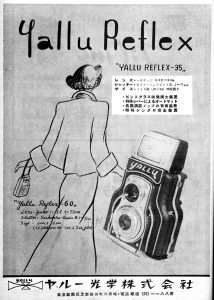
Beginning as Yallu Optical Co., Ltd. in 1949, the company developed a prototype 35mm TLR called the Yallu Flex which was inspired by the Zeiss-Ikon Contaflex which was another 35mm TLR introduced in 1935. The Yallu Flex seemed to have a lot of things going for it. It was based off a good German design with modern features for it’s day, and combined the ease of use of a TLR with the small compact size of a 35mm camera. Despite the signs that this would be a successful camera, excitement over the first 50 prototypes was lukewarm, and in the end it was never offered for sale.

After the failure of the Yallu Flex, the company regrouped and changed it’s name to Aires Camera Works, or K.K. Aires Shashinki Seisakusho in Japanese.
Controversial: There is some debate about the correct pronunciation of the name “Aires”. Each time I see it, my brain sees “Aries” like the constellation or sign of the Zodiac. The correct spelling is in fact, A I R E S, but I think it should be pronounced like EYE – RES. I can’t find any evidence of this fact, but the Japanese often used clever word play in their names, so my guess is that the first two letters intentionally sounded like the word “eye” which is in essence, what a camera is.
Since the company already had shown promise as a TLR maker, their first models from the early 1950s were all of the Twin Lens Reflex type. Instead of thinking outside of the box with 35mm, the company stayed with the much more common 120 roll film format.
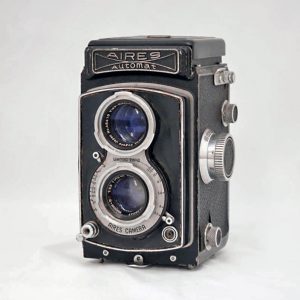
By 1954, Aires had released their top of the line model, the Aires Automat. A copy of the Rolleiflex, it featured a crank wind semi automatic film advance which also automatically cocked the shutter, Bay 1 filter mounts, and a familiar design. It also came with a Seikosha-Rapid shutter with M and X flash synchronization and either Zuiko (Olympus) and Nikkor (Nikon) lenses. In 1955, the price of an Aires Automat with leather case was 43,000 Yen, which was extremely high for the time.

Around this same time, Aires started to expand into the 35mm rangefinder market and released a new series of fixed lens cameras known as the Aires 35. Between the years of 1954 and 1959, the Aires 35 series saw many changes and sub-models. The Aires 35 III was the third sub-model in the line and featured many advanced features such as a single viewfinder window with superimposed rangefinder, a single crank film advance, and an excellent f/1.9 45mm Coral lens. Shortly after releasing the 35 III, the 35 V was released which had a range of interchangeable lenses with focal lengths from 35mm to 100mm.
In 1960, the Aires Radar-Eye was released and was based on the design of the earlier IIIC, improving on a couple of that camera’s features along with having the exposure meter of the Aires 35 IIIS. Upon it’s release, it was the most advanced and well featured of any 35mm camera ever released by Aires.
I could not find any information about what the Radar-Eye would have sold for or if it was even sold outside of Japan. The closest comparison I can make is to the IIIC, which sold in 1958 for $123.50, and it was common back in those days to release subsequent models with new features at a price similar to the model each model replaced, so it’s likely the Radar-Eye also sold for around $123.50, which if true, compares to about $1075 today.
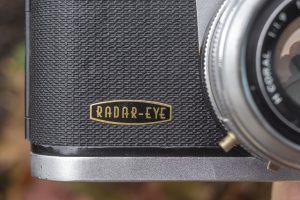
Sadly, by the time of it’s release, the writing was already on the wall for Aires as the company would succumb to bankruptcy less than a year after the Radar-Eye’s release. Even if it hadn’t, the photographic world was quickly moving onto Single Lens Reflex cameras, so the market for a high featured fixed lens rangefinder camera would have likely been very small. According to someone named Stephen on Flickr, less than 1000 Radar-Eyes were ever produced making them very difficult to find today. Normally I wouldn’t cite such a vague resource as ‘some guy on Flickr’, but so few of these cameras exist, I honestly believe that number is probably not far off from reality.
Today, Aires cameras are barely what I would consider collectible. I’ve never once in the five years I’ve been doing this run into anyone who says they specifically look for Aires cameras. Of the people who are aware of them, they’re generally regarded as good quality Japanese rangefinders, and on occasion when someone does already have one, they usually have good things to say about them.
The Radar-Eye specifically is an enigma. I didn’t even know the model existed until I saw this one for sale and if Stephen from Flickr is right and less than 1000 were made, it’s likely you’ve never heard of one either.
Edit 3/22/20: After posting this article, reader Bill Kraus contacted me and said he had some original Japanese language promotional material for the Radar-Eye including a pamphlet saying the camera sold for 22,000 Yen. I don’t understand Japanese, but thought these were interesting enough to share. The below gallery of images are all Bill’s images. Thanks Bill!
Repairs
I reviewed the Aires 35-III L back in July 2015, making it one of the earliest reviews I’ve written. I remember back then being impressed with the camera’s build quality and the sharpness of images I got from it. Not having ever heard of Aires before writing that article, that camera sent me down the rabbit hole of all the camera makers of the 20th century that have since gone out of business, never to be heard from again.
In the years since, I acquired another 35-III L which I fixed up and sold to another collector, a 35 IIIC which I had lusted after for a while, but could never get through a whole roll of film without it jamming, a Viscount that was DOA, and had a couple close calls with the 35V. I figured that at whatever time I published my next Aires review, it would be one of those models.
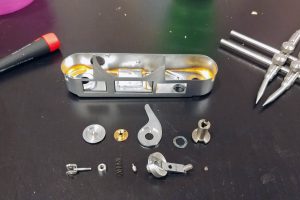
Then one day while browsing the big auction site, I saw something called the Aires Radar-Eye. What the heck was that? A quick look over at camera-wiki’s Aires page and the Radar-Eye isn’t even mentioned as a model. I had to pick it up. The camera looked to be well used and the seller described it as “AS/IS for Parts Only”. Now as anyone whose bought cameras like this, “AS/IS for Parts Only” can mean anything from a literal pile of parts, to a mint condition camera in perfect working order.
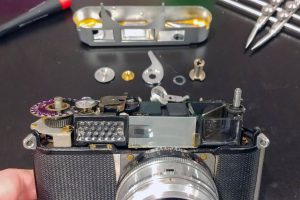
When it arrived, it was in very rough shape. The camera was dirty, had a nasty old filter over the lens, the shutter was stuck, the viewfinder was cloudy, and the exposure meter was rattling around under the top plate. I was able to remove the filter which revealed a pretty clean lens, and I was able to clean most of the gunk off the body.
The top plate came off easily and I noticed that two of the four screws that are supposed to hold the meter in place were missing and although I didn’t have any spare Aires cameras to salvage screws from, I do have enough broken cameras that I was able to find suitable replacements. The viewfinder was easy enough to clean as I wiped all of the glass surfaces except the beamsplitter. The beamsplitter did have some haze on it, but since beamsplitters are extremely fragile, I didn’t want to mess with it, so satisfied that the viewfinder was significantly improved, I just put it back together.
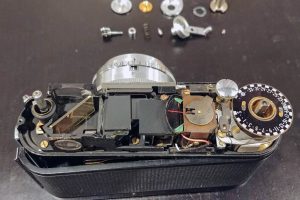
As for the shutter, I unscrewed the front lens ring, removed the front element and flushed the entire shutter with naphtha several times until it started to fire. Sadly, I never took any pictures of this repair process, but I assure you, there wasn’t much to see. I’ve done enough Japanese rangefinders that they all tend to look the same.
Even after getting the shutter to fire, I could tell there was still an issue with the camera’s LVS system. I already hate LVS systems on most cameras of this era as it is, but in this Aires, it feels like a gear is sheared or something inside of the lens barrel as I could only select exposure combinations with an LV of 8 to about 13. Since this translates into most outdoor photography except direct sunlight, I figured it was good enough and decided to just shoot it as is since the rest of the camera was working.

My Thoughts
Having previously handled the Aires 35 IIIC, it is clear that the Radar-Eye was the successor to that camera as both use the same body. Like all Aires rangefinders, the cameras are on the heavy side weighing in at 801 grams which is more than 220 grams heavier than a Leica M3 body at 580 grams. The increased weight is somewhat mitigated by the curved round edges and good ergonomics which give the illusion of a more compact and balanced camera.
Another plus is the inclusion of forward angled strap lugs that when connected to a neck strap, the angle of the lugs allows for the camera to hang easily from your neck without tipping forward. This is an often overlooked feature of many cameras where the lugs are on the extreme ends of the camera.
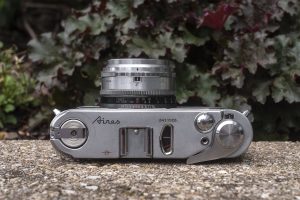
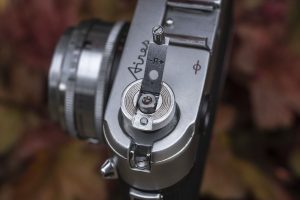
On the top plate, the Radar-Eye shares the IIIC’s recessed rewind knob. The far side of the top plate has a notch where the handle for the fold out crank can neatly tuck into the camera which allows for a completely flat surface when the rewind knob is not needed.
To use it, pull up on the handle and lift the entire knob to the rewind position and you can easily speed through a 36 exposure cassette in a matter of seconds.
The middle of the top plate has the accessory shoe and exposure match needle readout. This readout is designed in a way where light entering it through the top of the camera is reflected into the viewfinder above the visible image area, similar to the Voigtländer Vitomatic IIa.

Finally on the right, is the chromed dome shutter release, cable release socket, rapid wind lever, and automatic resetting exposure counter. The shutter release definitely stands out as being unique on this model and it certainly is pretty, but while shooting, I feel as though this is an example of form over function. In it’s natural resting position, the shutter release is flush with the raised ridge around it. Like all top plate shutter releases, a little bit of downward pressure is required to fire the shutter, and with this button, you have to press the domed part into the top plate of the camera which can be a bit awkward, especially if you have fat fingers. By no means is it a deal breaker, but it’s an example of a design element that looks a lot better than it performs.

The bottom of the camera features only the 1/4″ tripod socket, which is slightly offset, and the rewind mode activation button. Pressing this button with film loaded into the camera deactivates the sprockets in the film compartment allowing you to rewind the film back into the cassette.
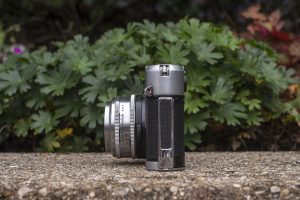
Opening the rear of the camera for loading film requires that you pull down on a release lever on the camera’s left side. Looking at this side of the camera also gives a good view of how the rewind crank folds into the top plate of the camera.
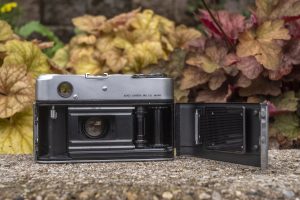
The film compartment looks like that of most other 35mm cameras of the day. Film transport is from left to right, over a sprocketed shaft and onto the fixed take up spool.
Inside of the film door is a pressure plate with divots and a rolling pin to help maintain smoothness while advancing film.
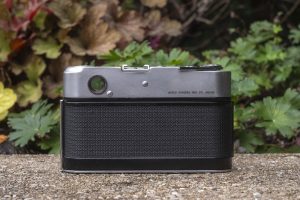
The back of the camera features only the circular eyepiece for the viewfinder and an engraving reminding you of who made the camera. Behind the small screw near the 4 o’clock position around the eyepiece is a rangefinder adjustment, should you ever need it.

Aires seems to be pretty good at designing viewfinders, as the one on the Radar-Eye is as big and bright as all others I’ve used. Once I got it cleaned up, the rectangular coincident image rangefinder patch was contrasty and easy to see. There are projected frame lines that have automatic parallax correction, which means they move to toward the lower right corner at minimum focus to eliminate parallax error.
Unlike my other Aires cameras however, is the inclusion of the metering system on the Radar-Eye. The movement of the match needle is a reflected image of the meter readout on the top plate. It uses light that enters through the window on the top of the camera, so if you are shooting in a dark room, you may have trouble seeing it. You also have to have your eye in just the right spot to see both the reflected meter and the viewfinder window as it tends to disappear unless your eye is perfectly centered in just the right spot.
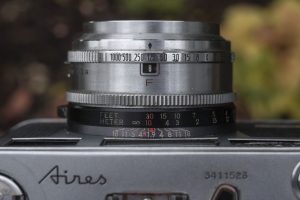
By far, my least favorite part of the Aires Eye is something that was also the camera’s biggest weakness, but even if I was reviewing this camera brand new in 1960, I still likely would have complained about. That thing is the coupled EV or LVS system.
As best as I can tell, and the reason I say that is because there clearly is some kind of issue on my camera with the coupling between the shutter speeds and f/stops. When selecting the correct exposure, you look at the exposure meter either through the top window or through the viewfinder and select an appropriate f/stop using the unmarked ring closes to the focus scale. Turning this ring both moves the red needle in the meter and smoothly chooses an f/stop between 1.9 and 16 which is visible in the square window. Once the red needle matches up with the other needle (it’s white when looking at the meter readout on the top plate, and black from within the viewfinder), you have correct exposure.
If you are unable to match the needles by just changing the f/stop, you then need to make an corresponding move with the shutter speed ring. The issue with this ring on my example is that something causes this ring to move very erratically. I had no issue changing f/stops, but the shutter speed ring was messed up somehow. Even if it wasn’t though, the issue is that both the shutter speed and aperture rings are coupled together and a move of one wants to move the other which is a huge pain in the butt. Many Kodak Retinas use a similar system in which once you have the proper exposure set, you can change both shutter speeds and f/stops with a single dial, while maintaining the same Exposure Value (EV). The Radar-Eye doesn’t show you EV numbers, but it essentially works the same way, and well, I hate it.
Beyond that though, the Aires Radar-Eye still has a lot going well for it. It’s got an attractive and ergonomically designed body, a flexible range of shutter speeds, a neat fold away rewind rank, and an excellent lens. Mine was good enough to still work, so what kinds of images did it make?
My Results
This Aires Radar-Eye came to me in very poor shape with several issues, but thankfully I was able to resolve most of them. The one I wasn’t able to resolve was an issue with the LVS coupling, which restricted my ability to select from all available shutter speeds and f/stops. As a result, I left the shutter speed at 1/125 and only selected between f/5.6 through f/11 for the entire roll. To maximize my chances at properly exposed photos, I chose fresh Kodak TMax 100 not only for it’s compatibility with a 1/125 shutter speed, but also for it’s extreme latitude which meant I should be able to correct for any over or underexposed shots.
As I had hoped, my choices of film and a single shutter speed proved to be the right one as nearly the entire roll came out pretty close to properly exposed. Even more impressive was that despite the poor shape this camera came to me in, it was still able to deliver nice and sharp images.
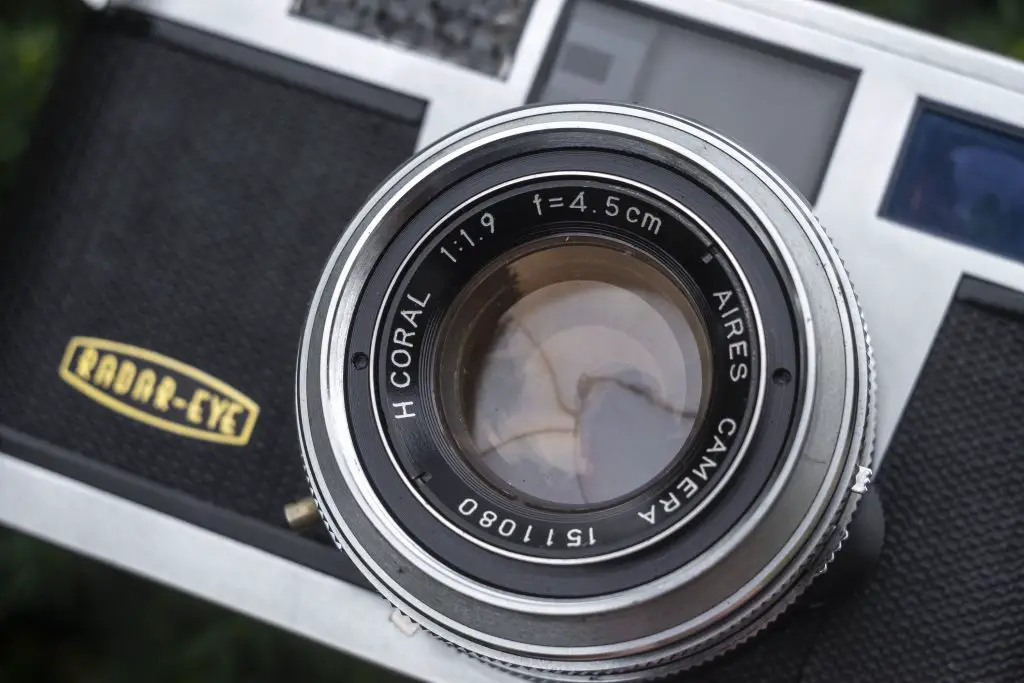
Like the results I got from the earlier Aires 35-III L, the Radar-Eye’s H Coral lens holds it’s own to any other fixed lens rangefinder out there. Despite the cloudy and overcast winter light that I shot these images in, contrast is nice, sharpness is excellent across the frame, and there is little to no vignetting or any other optical anomalies visible. I didn’t shoot this camera using color film, but I’ve seen what the same lens on other Aires rangefinders can do, so I have no doubt that this camera would have produced similarly excellent images.
While walking around with this camera, I never had to second guess the location of the controls. The viewfinder was bright and easy to use, the film advance lever was just tight enough to feel reassuring without being gritty or wobbly. I didn’t love the shutter release as your finger has to go below the top plate when pressing it, but it was only a minor nuisance. Since I never changed shutter speeds, I didn’t have to mess with the LVS system which I probably would have complained about had I did, so in a way, this camera’s limitations worked in it’s favor.
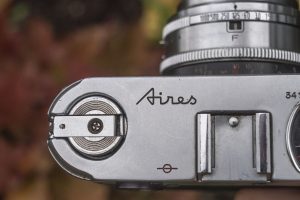
Aires, more than any other extinct camera company, might be my selection for the company with the biggest missed opportunity. Aires rangefinders are very solid and generally well built. The control layouts on them are as good as anything out there, and their Coral lenses are optically excellent. This was a company that knew how to design and build an excellent product. They just didn’t know how to stand out in a crowded Japanese camera market and ultimately failed. I just can’t help but wonder what could have been if Aires had caught a break and succeeded in the decades that would follow.
The Radar-Eye is a very uncommon camera, and while I came away from this experience highly impressed, I probably shouldn’t recommend anyone go searching for one as you won’t likely find one easily. Assuming you can live without a meter (which you should), I would definitely recommend the predecessor to this model, the 35 IIIC, or even the 35-III L as they are equally as fun to use and have the same lens.
Related Posts You Might Enjoy
External Links
http://www.asahi-net.or.jp/~RD2H-ARI/BUN_RADEREYE.htm (in Japanese)
http://corsopolaris.net/supercameras/aires/aires.html
http://www.ajcc.gr.jp/sub1.45.html#Radar%20Eye (in Japanese)
http://blog.livedoor.jp/kaede_photo/archives/36030089.html (in Japanese)
http://www.collection-appareils.fr/x/html/camera-10349-Aires_Radar%20Eye.html

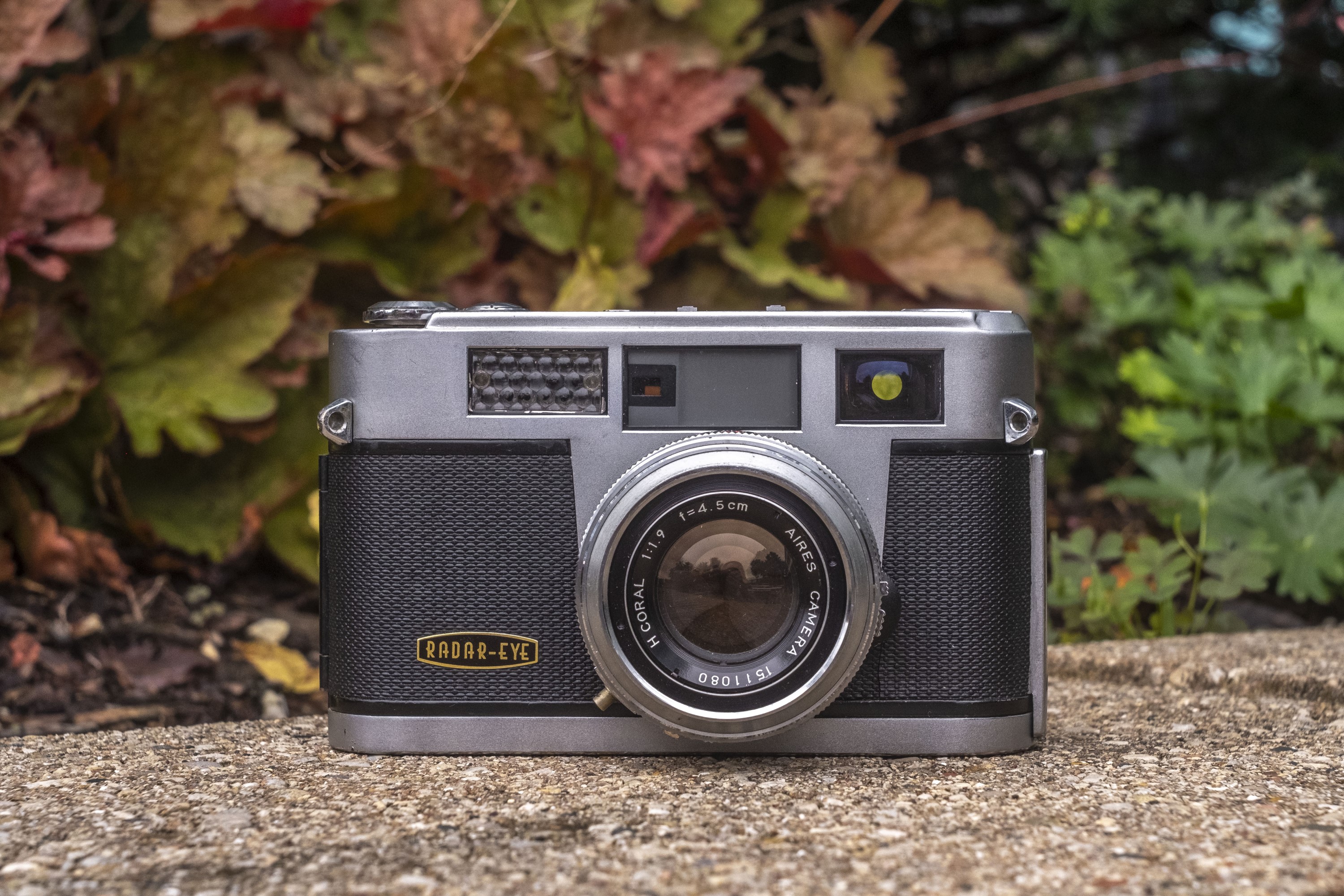





















The 35 III L may be a more practical camera -but few names are as cool as Radar Eye
I agree about the name. Although while writing this review, I kept hearing Golden Earring’s “Radar Love” in my head! 🙂
Brenda Lee’s ‘Comin’ on Strong’
Very “pretty” camera — and great shots (I’d love to explore that abandoned “mansion”) — I picked up an Aires Viscount on shopgoodwill.com and just cleaned up the outside — it was my first “vintage” rangefinder camera — and it was easy to use and produced great photos. The shutter seems pretty accurate and the lens is very sharp. The viewfinder and rangefinder look to need some internal cleaning, but they were OK enough for me to compose and focus. Thanks Mike for giving us more info on great vintage cameras!
You’re welcome Dana, like you said, Aired cameras seem to always make sharp photos, regardless of which model. It’s a shame they didn’t survive!
I thought I had seen all the Aires cameras by now. This is the first I have seen one of these which goes to how rare it must be. Does it mean I have to go out and find one? Well, I can’t go out as my office is closed which means I have all the time in the world to search. Ah, but first I’ll go out and change the oil in a car. Hobbies are going to come in handy right now and I have a few.
Yeah, I hadn’t either until I saw this one for sale and I haven’t seen any since! That’s why at the end of my review, despite getting great shots from it, I wouldn’t recommend people go out and find one as they’re no better than earlier Aires cameras…but I guess if you’re a completest, you have no choice! 🙂
Oh well… I have spotted one of these… But the seller didn’t agree to ship it. In person only sell… But I live 1000 km away… Anyway… After 6 months the camera was still there for sale… Price dropped 3 times… I begged… And begged… And finally the seller agreed to ship the camera. The beast has been shipped. I’m waiting to receive it. Fingers crossed about conditions. Thanks for all the info on this camera.
Fingers crossed it shows up in good working order as I am certain they’re nice cameras. Mine was in BARELY working order and would love to have a nicer example some day.